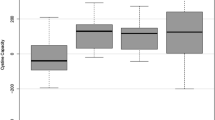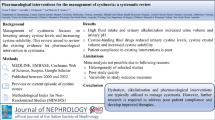Abstract
The formation of stones in patients with cystinuria can be counteracted by reducing the urinary concentration of cystine and by increasing its solubility. Thirty-one patients with homozygous cystinuria and treated with tiopronin (2-mercaptopropionylglycine) were followed for between 0.4 and 12 years (median 8.8). With the aim of avoiding cystine concentrations above 1200 μmol/l, the daily dose varied between 500 and 3000 mg (median 1500). The therapeutic effect was evaluated from the clinical symptoms and repeated radiographic examinations. The rate of stone formation during the treatment period was reduced by 60% in comparison with the pretreatment period (P< 0.001). The frequency of active stone removal was reduced by 72% (P< 0.05). The formation of new stones was associated with a higher cystine concentration than was the case during periods when stone formation and stone growth were excluded (P< 0.005). The probability of new stone formation increased with increasing concentrations of cystine up to 1100 μmol/l, but stone formation was not accentuated above 1200 μmol/l. There was no significant relationship between the 24 h excretion of cystine and stone formation.
It is concluded that the formation of cystine stones can be efficiently counteracted during treatment with tiopronin, guided by analysis of the concentration of urinary cystine.
Similar content being viewed by others
References
Ackermann D, Griffith DP, Dunthorn M, Newman RC, Finlayson B (1989) Calculation of stone volume and urinary stone staging with computer assistance. J Endourol 3:355
Ahlstrand C, Tiselius H-G (1993) Treatment of cystine urolithiasis by a combination of extracorporeal shock wave lithotripsy and chemolysis. J Stone Dis 5:32
Bek-Jensen H, Tiselius H-G (1989) Stone formation and urine composition in calcium stone formers without medical treatment. Eur Urol 16:144
Boström H (1959) Cystinurial in Sweden. III. Prognosis of homozygous cystinuria. Acta Chir Scand 116:287
Carlsson MS, Denneberg T, Emanuelsson B-M, Kågedal B, Lindgren S (1993) Pharmacokinetics of oral tiopronin. Eur J Clin Pharmacol 45:79
Carlsson MS, Denneberg T, Emanuelsson B-M, Kågedal B, Lindgren S (1994) Steady state pharmacokinetics of 2-mercaptopropionyl-glycine (tiopronin) in healthy volunteers and patients with cystinuria. Drug Invest 7:41
Carlsson MS, Denneberg T, Emanuelsson B-M, Kågedal B, Lindgren S (1994) Pharmacokinetics of 2-mercaptopropionyl-glycine (tiopronin) in patients with impaired renal function. Drug Invest 7:74
Crawhall JC (1987) Cystinuria—an experience in management over 18 years. Miner Electrolyte Metab 13:286
Crawhall JC, Scowen EF, Watts RWE (1963) Effect of penicillamine on cystinurial B M J 1:588
Dahlberg PJ, Berg CJ van den, Kurtz SB, Wilson DM, Smith LH (1977) Clinical features and management of cystinuria. Mayo Clin Proc 52:533
Denneberg T, Jeppsson J-O, Stenberg P (1983) Alternative treatment of cystinuria with alpha-mercaptopropionylglycine, Thiola®. Proc EDTA 20:427
Dent CE, Senior B (1955) Studies on the treatment of cystinuria. Br J Urol 27:317
Dent CE, Friedman M, Green H, Watson LCA (1965) Treatment of cystinuria. B M J 1:403
Ekberg M, Jeppsson J-O, Denneberg T (1974) Penicillamine treatment of cystinuria. Acta Med Scand 19:415
Halperin EC, Thier SO, Rosenberg LE (1981) The use of D-penicillamine in cystinuria: efficiacy and untoward reactions. Yale J Biol Med 54:439
Hambreus L, Lagergren C (1962) Biophysical and roentgenological studies of urinary calculi from cystinurics. Cystinuria in Sweden, part VI. J Urol 88:826
Hautmann RE (1981) Cystine-stone therapy with alpha-mercaptopropionyl-glycine — ten years experience with forty-two patients. In: Smith LH, Robertson WG, Finlayson B(eds) Urolithiasis: clinical and basic research. Plenum Press, New York, p 139
Herring LC (1962) Observations on the analysis of ten thousand urinary calculi. J Urol 88:545
Jaffe IA (1986) Adverse effects profile of sulfhydryl compounds in man. Am J Med 80:471
Jeppsson J-O, Karlsson IM (1972) Ion-exchange chromatography of physiological sulphur amino acids on a highly crosslinked resin. J Chromat 72:93
Kallistratos G, Timmerman A (1968) Über die Wirkung von Thiola. Naturwissenschaften 55:648
Koide T, Kinoshita K, Takemoto M, Yachiku S, Sonoda T (1982) Conservative treatment of cystine calculi: effect of oral alpha-mercaptopropionylglycine on cystine stone dissolution and on prevention of stone recurrence. J Urol 128:513
Linari F, Marangella M, Fruttero B, Bruno M (1981) The natural history of cystinuria: a 15 year follow up in 106 patients. In: Smith LH, Robertson WG, Finlayson B (eds) Urolithiasis: clinical and basic research. Plenum Press, New York, p 145
Lindell Å, Denneberg T, Eneström S, Fich C, Skogh T (1990) Membranous glomerulonephritis induced by 2-mercaptopropionylglycine (Thiola®). Clin Nephrol 34:108
Lotz M, Potts JT, Holland JM, Kiser WS, Bartter FC (1966) D-Penicillamine therapy in cystinuria. J Urol 95:257
Miano L, Gallucci M, Petta S (1979) Results of medical treatment of cystine lithiasis. Tratto da Eur Urol 5:265
Pak CYC, Fuller C (1983) Assessment of cystine solubility in urine and of heterogeneous nucleation. J Urol 129:1066
Pak CYC, Fuller C, Sahaee K, Zerwekh JE, Adams BV (1986) Management of cystine nephrolithiasis with alpha-mercaptopropionyl-glycine. J Urol 136:1003
Remien A, Kallistratos G, Burchardt P (1975) Treatment of cystinuria with Thiola (alpha-mercaptopropionylglycine). Eur J Urol 1:227
Tiselius H-G (in press) Solution chemistry of supersaturation. In: Coe F, Favus M, Pak C, Parks J, Preminger G (eds) Kidney stones: medical and surgical management. Raven Press, New York
Author information
Authors and Affiliations
Rights and permissions
About this article
Cite this article
Lindell, Å., Denneberg, T., Hellgren, E. et al. Clinical course and cystine stone formation during tiopronin treatment. Urol Res 23, 111–117 (1995). https://doi.org/10.1007/BF00307941
Received:
Accepted:
Issue Date:
DOI: https://doi.org/10.1007/BF00307941




